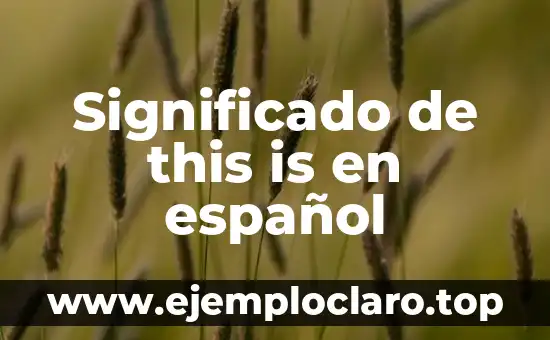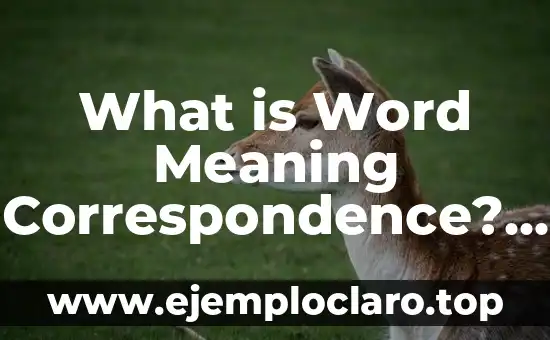Word meaning correspondence refers to the relationship between words and their meanings, exploring how language assigns meaning to words. This concept is crucial in linguistics, psychology, and communication, as it examines how we understand and use words effectively.
What is Word Meaning Correspondence?
Word meaning correspondence is the study of how words in a language relate to their meanings. It delves into the connection between linguistic forms and their conceptual meanings, essential for effective communication.
Historically, this concept has been explored by linguists like Ferdinand de Saussure, who discussed the arbitrary nature of the sign, highlighting that words are symbols with no inherent meaning except that assigned by culture and convention.
The Relationship Between Language and Meaning
The bond between language and meaning is fundamental to communication. Words are symbols that convey concepts, emotions, and ideas, shaped by cultural and social contexts. This relationship is dynamic, evolving as languages change over time.
También te puede interesar

The world of boxing is buzzing with excitement as two of the most popular internet personalities, KSI and Tommy Fury, are set to face off in the ring. The highly anticipated fight has been making headlines for months, and fans...

In the realm of travel, vivid experience tourism refers to a form of tourism centered around immersive and meaningful experiences. This concept goes beyond traditional sightseeing, emphasizing engagement with local cultures, environments, and communities. It's about creating lasting memories through...

¿Alguna vez has jugado a Sims 4 y te has preguntado dónde está el hospital? No estás solo. Muchos jugadores de Sims 4 se han encontrado en la misma situación, especialmente después de instalar paquetes de expansión como Get to...

Yesterday Is History o El ayer es historia es una expresión que invita a reflexionar sobre el pasado y el presente. Este dicho, que se ha popularizado en diferentes culturas, sugiere que lo que sucedió ayer ya forma parte de...

En el idioma español, la expresión this is se traduce como esto es. Aunque pareciera sencilla, esta frase tiene un significado profundo y versátil que se utiliza en una variedad de contextos. A lo largo de este artículo, exploraremos detalladamente...

This Is Me Now es el título del próximo álbum de estudio de la cantante y actriz Jennifer Lopez, que se espera que sea lanzado en un futuro cercano. Este álbum marca un nuevo capítulo en la carrera de la...
For instance, the word nice originally meant foolish but now means pleasant, showing how meanings can shift significantly over centuries.
Examples of Word Meaning Correspondence
- Homographs: Words with multiple meanings, like bank (financial institution) and bank (river side).
- Metaphors: Using words to represent abstract concepts, such as time is money.
- Synonyms: Different words with similar meanings, like happy and joyful.
Understanding these examples helps in grasping the complexity of word meaning correspondence.
The Theoretical Framework Behind Word Meaning
The theoretical framework involves semantics and pragmatics. Semantics studies word meanings, while pragmatics explores how context affects meaning. This framework helps in understanding how words convey meaning beyond their literal sense.
For example, the phrase It’s cold in here might be a request to close the window, showing how context influences meaning.
5 Key Concepts in Word Meaning Correspondence
- Polysemy: A word with multiple related meanings, like head (body part or leader).
- Homonymy: Words with the same spelling but different meanings, like bat (animal or sports equipment).
- Metonymy: Using a word to represent something closely related, like White House for the administration.
- Synonymy: Words with similar meanings, like big and large.
- Antonymy: Words with opposite meanings, like hot and cold.
These concepts illustrate the complexity of word meaning correspondence.
Understanding Meaning Beyond Words
Meaning is not just about words; context, tone, and gesture play roles. For example, saying I’m fine can mean different things depending on tone, showing that interpretation goes beyond the words themselves.
What is the Purpose of Word Meaning Correspondence?
Word meaning correspondence helps in understanding how language works, essential for communication, translation, and language learning. It aids in creating clear expressions and interpreting others’ messages accurately.
For instance, understanding word meanings is crucial for effective translation, ensuring that nuances are preserved across languages.
Exploring Semantic Fields
Semantic fields are groups of words related by meaning, like food or emotions. These fields show how words are interconnected, influencing each other’s meanings and usage.
For example, the word hot can relate to temperature or emotions, illustrating the interconnected nature of semantic fields.
The Role of Context in Shaping Meaning
Context significantly influences word meaning. The same word can have different meanings in different situations, highlighting the dynamic nature of language.
For example, spring can refer to a season or a coiled metal object, depending on context.
The Significance of Word Meaning
Understanding word meaning is vital for effective communication. It allows us to express ideas clearly and interpret others’ messages accurately, forming the basis of human interaction.
This understanding is foundational in education, helping learners grasp language structures and vocabulary.
The Origin of Word Meaning
The origin of word meaning often lies in cultural and historical contexts. Words can evolve from ancient roots, with meanings changing over time due to societal shifts.
For example, quarantine originated from the Italian for 40 days, referring to isolation periods during the Black Death.
Delving into Lexical Semantics
Lexical semantics studies the meanings of words and how they combine to form sentences. It examines how words convey meaning both in isolation and in context.
This field helps in understanding how language conveys complex ideas through word combinations.
How Do Words Acquire Meaning?
Words acquire meaning through social agreement and cultural context. Meanings are not fixed and can change over time, influenced by historical and social factors.
For example, awful originally meant awe-inspiring but now means bad, showing how meanings evolve.
Practical Applications of Word Meaning Correspondence
Understanding word meaning is practical in translation, education, and communication. It helps in creating precise texts, teaching language, and improving interpersonal interactions.
For instance, in translation, grasping word meanings ensures that nuances are preserved, maintaining the original message’s intent.
INDICE

